The Intel Core i9-9900K, while no longer the latest processor on the market, remains a capable CPU for gaming and demanding productivity tasks. Its 8-core, 16-thread architecture and significant overclocking potential have given it a long lifespan. However, pairing it with a suitable motherboard is crucial to unlock its full performance, a task that has become more nuanced.
This guide provides a purely informational overview of the Z390 motherboards that were popular choices for the i9-9900K. We will explore their features, current market status, and provide the objective details needed for anyone looking to build, maintain, or upgrade a system around this specific processor.
Understanding the i9-9900K and Z390 Chipset in 2025
The i9-9900K processor uses the LGA 1151 socket and is best paired with a motherboard featuring the Z390 chipset. This combination was the flagship offering from Intel during its time, designed for enthusiasts seeking maximum performance.
It is important to note that Z390 motherboards are no longer in production. Anyone seeking a motherboard for an i9-9900K today will almost certainly be purchasing from the second-hand market (e.g., eBay, local marketplaces). This makes understanding the original features and build quality of these boards more important than ever. If you’re unsure about your current hardware, you might wonder, “What motherboard do I have?,” before seeking a replacement.
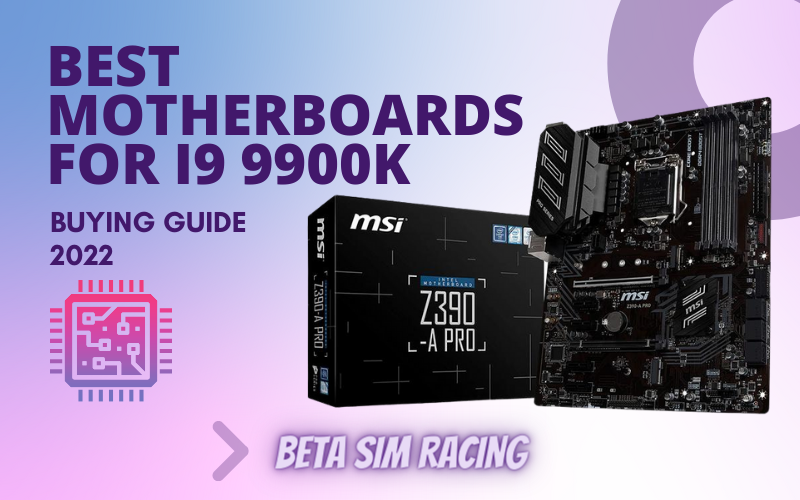
Comparison of Top Z390 Motherboards for the i9-9900K
This table offers a direct comparison of the key specifications for the motherboards detailed in this guide. All models are discontinued but can be found on the used market.
| Feature | GIGABYTE Z390 AORUS ULTRA | MSI MPG Z390 Gaming Pro Carbon AC | MSI Z390-A PRO | GIGABYTE Z390 I AORUS PRO WiFi | Gigabyte Z390 M Gaming |
| Status | Discontinued | Discontinued | Discontinued | Discontinued | Discontinued |
| Form Factor | ATX | ATX | ATX | Mini-ITX | Micro-ATX |
| Chipset | Intel Z390 | Intel Z390 | Intel Z390 | Intel Z390 | Intel Z390 |
| VRM Phases | 12+1 | 10+2 | 8+1 | 6+2 | 10+2 Hybrid Digital |
| Memory Support | 4x DDR4, up to 128GB | 4x DDR4, up to 128GB | 4x DDR4, up to 128GB | 2x DDR4, up to 64GB | 4x DDR4, up to 128GB |
| Max Memory Speed | 4400MHz (OC) | 4400MHz (OC) | 4400MHz (OC) | 4400MHz (OC) | 4133MHz (OC) |
| PCIe 3.0 x16 Slots | 3 (x16, x8, x4) | 3 (x16, x8, x4) | 2 (x16, x4) | 1 (x16) | 2 (x16, x4) |
| M.2 Slots | 3 x PCIe 3.0 x4 | 2 x PCIe 3.0 x4 | 1 x PCIe 3.0 x4 | 2 x PCIe 3.0 x4 | 2 x PCIe 3.0 x4 |
| SATA III Ports | 6 | 6 | 6 | 4 | 6 |
| Onboard WiFi | Intel CNVi 802.11ac | Intel 802.11ac | No | Intel CNVi 802.11ac | No |
| Rear USB 3.1 Gen2 | 3x Type-A, 1x Type-C | 1x Type-A, 1x Type-C | 2x Type-A | 2x Type-A | 1x Type-A |
Key Factors When Selecting a Used Z390 Motherboard
When buying a motherboard on the used market, especially for a power-hungry CPU like the i9-9900K, certain factors are critical. Knowing which function a motherboard’s chipset performs is the first step.
The Z390 Chipset Advantage
The Z390 was the top-tier chipset for Intel’s 9th generation processors. Its primary advantages over its predecessor, the Z370, were integrated Intel Wireless-AC (WiFi) and native USB 3.1 Gen 2 support, reducing the reliance on third-party controllers. It is the ideal platform for overclocking the i9-9900K.
Voltage Regulator Module (VRM) Quality
The VRM is responsible for delivering clean and stable power to the CPU. The i9-9900K can draw a significant amount of power, particularly when overclocked.
Expert Insight: A motherboard with a more robust VRM design (e.g., more power phases and better cooling) will handle the i9-9900K’s power demands more effectively, leading to better system stability and potentially higher overclocks. A board with a high phase count and substantial heatsinks on the VRM is highly desirable.
Form Factor: ATX, Micro-ATX, and Mini-ITX
The physical size of the motherboard determines case compatibility and often dictates the number of expansion slots. For a detailed breakdown, see our guide on Micro ATX vs Mini ITX vs ATX.
- ATX: The standard size, offering the most PCIe slots, RAM slots, and connectivity. Ideal for most builds.
- Micro-ATX (mATX): A shorter board that fits in more compact cases but has fewer PCIe slots.
- Mini-ITX (mITX): The smallest form factor, designed for compact builds with only one PCIe slot.
BIOS Version and Compatibility
While all Z390 motherboards support the i9-9900K, some early models may require a BIOS update to function correctly. When purchasing a used board, it’s beneficial if the seller can confirm the BIOS version or if it was previously used with a 9th-gen CPU. Learning how to update motherboard BIOS is a valuable skill for any PC builder.
Availability and the Second-Hand Market
As these boards are discontinued, your only options are used marketplaces. Exercise caution and check seller ratings. Whenever possible, obtain boards that have been tested and verified to be in working condition. Knowing how to clean a motherboard properly can be useful when you receive a used part.
A Detailed Look at 5 Notable Z390 Motherboards for the i9-9900K
Here is an objective analysis of five Z390 models that were well-regarded for their performance and features with the i9-9900K.
1. GIGABYTE Z390 AORUS ULTRA
The GIGABYTE Z390 AORUS ULTRA was a high-end motherboard designed for enthusiasts. It was widely recognized for its excellent power delivery system and comprehensive feature set, making it a prime candidate for overclocking the i9-9900K.
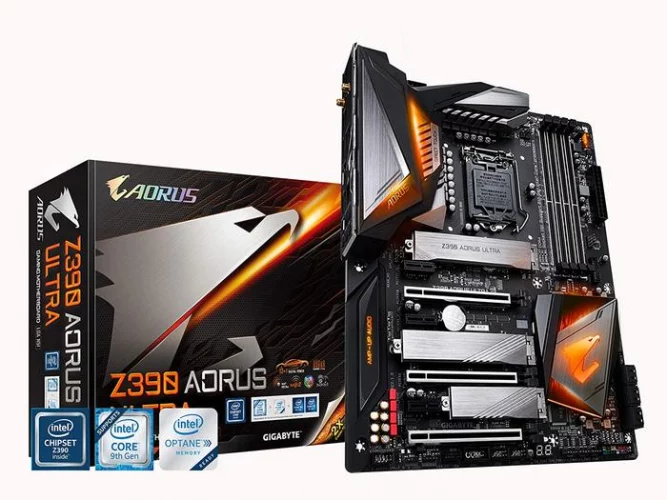
Core Features
- VRM: A robust 12+1 phase digital VRM with high-quality power stages and large, direct-touch heatpipe heatsinks. This design is exceptionally well-suited for handling the sustained load of an overclocked i9-9900K.
- Storage: Excellent storage flexibility with three M.2 slots, all equipped with thermal guards to prevent throttling, and six SATA ports.
- Connectivity: Features integrated Intel CNVi 802.11ac Wave2 Wi-Fi, Bluetooth 5, and Intel Gigabit LAN. Its rear I/O is rich with USB ports, including a USB Type-C port.
- Cooling and Aesthetics: RGB Fusion lighting, multiple fan headers, and dedicated water pump headers made it a flexible choice for users who prioritize both performance and looks, especially in one of the best airflow PC cases.
Status and Modern Alternative Consideration
- Status: Discontinued. This model is highly sought after on the used market due to its strong VRM and feature set.
- Modern Alternative: For a user considering a new build, a comparable modern system would be an Intel Core i5-14600K paired with a mid-range Z790 motherboard. This combination would offer superior performance, access to DDR5 memory, and PCIe 5.0 support.
2. MSI MPG Z390 Gaming Pro Carbon AC
The MSI MPG Z390 Gaming Pro Carbon AC struck a balance between high-end features and aesthetics without the premium price of flagship models. It was a popular choice for gamers who wanted strong performance and customizable RGB lighting.
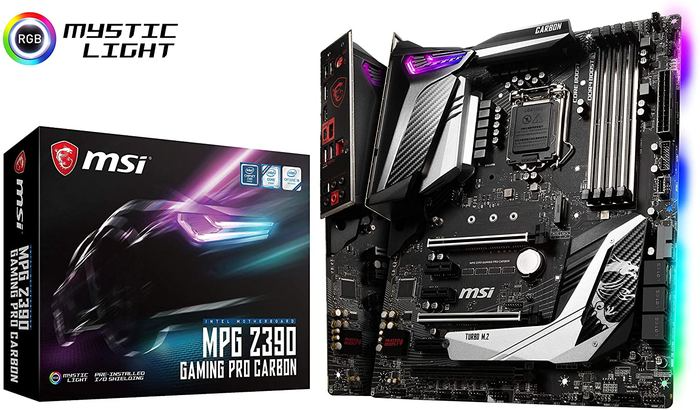
Core Features
- VRM: Features a capable 10+2 phase VRM with substantial heatsinks, providing reliable power for the i9-9900K, including for moderate to high overclocking.
- Storage: Equipped with two M.2 slots (one with MSI’s M.2 Shield Frozr heatsink) and six SATA ports.
- Connectivity: Includes Intel 802.11ac Wi-Fi and Bluetooth, along with Intel Gigabit LAN. The rear panel provides a good mix of USB 3.1 Gen2 Type-A and Type-C ports.
- Aesthetics: Known for its carbon fiber accents and extensive Mystic Light RGB system, allowing for significant visual customization.
Status and Modern Alternative Consideration
- Status: Discontinued. A popular all-around board that is frequently available on second-hand sites.
- Modern Alternative: A current-generation equivalent would be a system based on an AMD Ryzen 7 7700X CPU and a B650 motherboard. This would provide a significant performance uplift, more modern I/O, and the efficiency of the Zen 4 architecture. For those still exploring AMD options, our guide to the best motherboards for Ryzen 9 5900X provides context on what makes a good board.
3. MSI Z390-A PRO
The MSI Z390-A PRO was a workhorse motherboard that focused on delivering core functionality and stability at an accessible price point. It eschewed flashy aesthetics like RGB lighting in favor of a solid, reliable design.
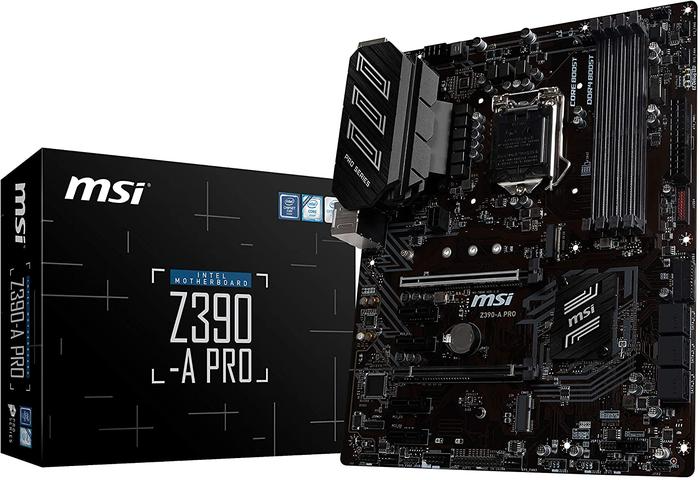
Core Features
- VRM: Its 8+1 phase VRM is sufficient for running the i9-9900K at stock speeds or with mild overclocking. The extended heatsink design helps manage temperatures under load.
- Storage: Provides the essentials with a single Turbo M.2 slot and six SATA ports.
- Industrial Design: Features a professional, understated black and silver design. It also includes Core Boost technology, which optimizes power delivery to the CPU.
- Expansion: Offers two full-length PCIe slots, making it suitable for builds with a primary graphics card and one other expansion card. When installing components, it’s crucial to know about essentials like what are motherboard standoffs.
Status and Modern Alternative Consideration
- Status: Discontinued. As one of the more common Z390 boards, it is often one of the most affordable options on the used market.
- Modern Alternative: A user looking for a budget-oriented but powerful new build could consider an Intel Core i5-13400 paired with a B760 motherboard. This would provide excellent gaming performance and modern features with a clear upgrade path.
4. GIGABYTE Z390 I AORUS PRO WiFi
This Mini-ITX motherboard was a remarkable piece of engineering, packing high-end performance into a tiny footprint. It was the go-to choice for building a powerful small form factor (SFF) PC with an i9-9900K.
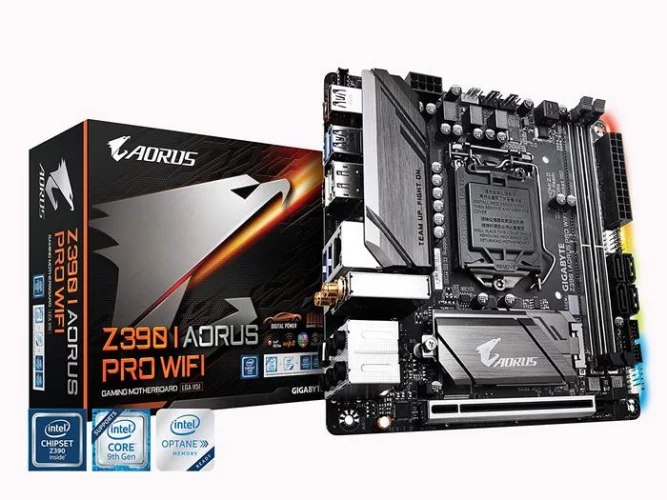
Core Features
- VRM: Utilizes a 6+2 phase digital VRM with advanced thermal design, including a substantial heatsink, which was impressive for its size and capable of handling an i9-9900K.
- Compact Power: Despite its small size, it does not compromise on key features, making it ideal for powerful builds in unique PC cases.
- Storage: Cleverly includes two M.2 slots (one on the rear of the board) and four SATA ports.
- Connectivity: Comes fully equipped with Intel CNVi 802.11ac Wi-Fi, Bluetooth 5, and a host of rear USB ports.
Status and Modern Alternative Consideration
- Status: Discontinued. This remains a very popular and often pricey board on the used market due to its unique capabilities for SFF builds.
- Modern Alternative: A modern SFF powerhouse could be built using an AMD Ryzen 7 7800X3D and a Mini-ITX B650I or X670I motherboard, offering top-tier gaming performance in a compact package.
5. Gigabyte Z390 M Gaming
The Gigabyte Z390 M Gaming catered to the Micro-ATX segment, offering a solid set of gaming-focused features in a smaller form factor than standard ATX boards. It provided a great foundation for a compact yet powerful gaming rig.
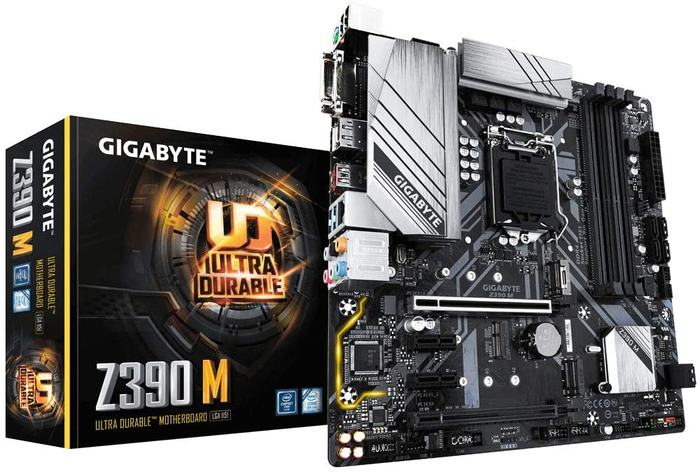
Core Features
- VRM: Features a 10+2 phase hybrid digital VRM with a modest heatsink. It’s capable of running the i9-9900K effectively, though extensive overclocking would require good case airflow.
- Form Factor: Its Micro-ATX size allows for more compact PC builds than a full ATX board while still offering more expansion than Mini-ITX. A good fit for many best micro ATX cases.
- Storage: Comes with two M.2 slots for high-speed NVMe SSDs and six SATA ports.
- Connectivity: Includes Realtek 8118 Gaming LAN but lacks onboard Wi-Fi, which would need to be added via a PCIe card or USB adapter.
Status and Modern Alternative Consideration
- Status: Discontinued. Offers a good middle-ground option on the used market for those who want a smaller build without the constraints of Mini-ITX.
- Modern Alternative: A comparable Micro-ATX build today might feature an Intel Core i5-14400 and a Micro-ATX B760 motherboard, delivering excellent multi-core performance in a compact and efficient package.
Frequently Asked Questions (FAQ)
Is the Intel i9-9900K still a good processor?
The i9-9900K is still a very competent processor for many tasks, especially 1080p and 1440p gaming. While modern CPUs offer better performance and efficiency, if you already own an i9-9900K, it can still provide a great experience and is not in immediate need of an upgrade unless you require the absolute best performance or features like PCIe 5.0.
What chipset does the i9-9900K use?
The i9-9900K was designed for motherboards with the Intel 300 series chipset. For full functionality, especially overclocking, the Z390 chipset is the intended and optimal choice.
Can you use a Z370 motherboard with an i9-9900K?
Yes, it is physically possible to use an i9-9900K in many Z370 motherboards, but it is conditional. It requires a specific BIOS update that adds support for 9th generation CPUs. Without this update, the system will not boot. Furthermore, many Z370 boards had weaker VRM designs that were not built to handle the i9-9900K’s power draw, potentially limiting performance. A Z390 motherboard is the more reliable choice.
Is it worth buying a Z390 motherboard?
It is only worth buying a Z390 motherboard if you already own an Intel i9-9900K and your current motherboard has failed, or if you acquire the CPU for a very low price. For anyone building a new PC from scratch, investing in a current-generation platform (like Intel’s Z790 or AMD’s B650) is a much better long-term decision, offering superior performance, a warranty, and modern features.
How do I test a used motherboard?
When buying a used board, it’s wise to test it thoroughly. If possible, ask the seller for a video of it booting into BIOS. Once you have it, inspect for physical damage, check all RAM slots, test all USB and SATA ports, and monitor system stability under load. Running a memory diagnostic test and a CPU stress test can help reveal potential issues. Knowing how to tell if your power supply is bad or motherboard can also help in diagnostics.
What is a good modern alternative to an i9-9900K and Z390 setup?
A strong mid-range alternative would be an Intel Core i5-14600K with a Z790 motherboard or an AMD Ryzen 7 7700X with a B650 motherboard. Both options would provide a significant performance increase, better power efficiency, support for faster DDR5 RAM, and more advanced connectivity options.

Holding a Ph.D. in Computer Science, Dr. Alistair Finch is our chief PC Component Benchmark Analyst. He provides meticulous, data-driven analysis of CPUs and GPUs, moving beyond marketing claims to reveal their true performance. His guides help readers understand the intricate relationship between hardware architecture and real-world gaming frame rates.
